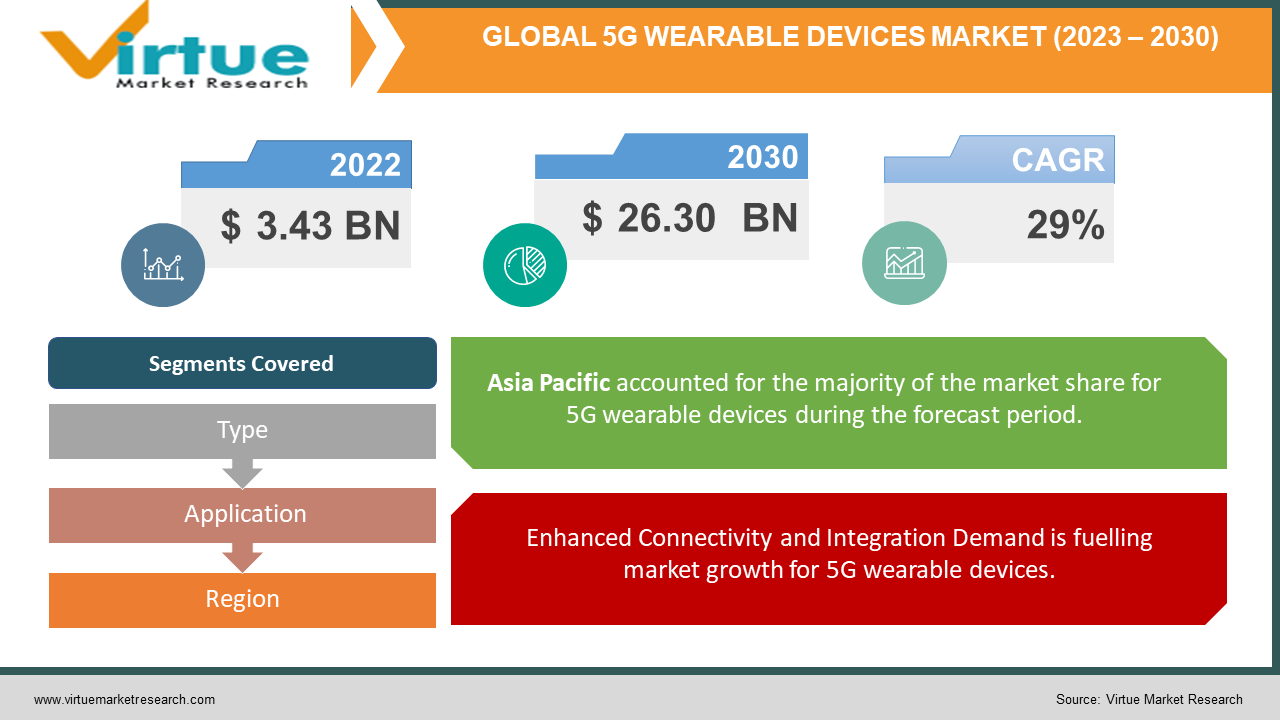5G Wearable Devices Market Size (2023 – 2030)
The Global 5G Wearable Devices Market was estimated to be worth USD 3.43 Billion in 2022 and is projected to reach a value of USD 26.30 Billion by 2030, growing at a fast CAGR of 29% during the forecast period 2023-2030.
The market for wearables with 5G connectivity capabilities is referred to as the worldwide 5G wearable devices market. These gadgets take advantage of the 5G networks' higher speed, low latency, and capacity to provide better connectivity, data transfer, and communication functions. Various wearable gadgets, including smartwatches, fitness trackers, augmented reality (AR) glasses, smart clothes, and wearables, are available on the market. As consumers appreciate the ease and functionality they provide, wearable technology has been slowly gaining popularity. The incorporation of a 5G connection is being driven by the need for smartwatches, fitness trackers, and other wearables to improve user experience and enable cutting-edge functionality. The widespread use of 5G wearable devices is made possible by the rollout and expansion of 5G network infrastructure across numerous locations. The market for 5G wearables is predicted to expand more as 5G networks spread throughout society and become more widely available. The creation of more sophisticated and functional 5G wearable devices is being fuelled by ongoing technological developments, including downsizing, longer battery life, and higher processing power. These developments foster market expansion while improving the overall user experience.
Global 5G Wearable Devices Market Drivers:
Enhanced Connectivity and Integration Demand is fuelling market growth for 5G wearable devices.
The rollout of 5G networks offers quicker and more dependable connectivity, enabling wearable gadgets to have better communication and data transfer capabilities. The demand for 5G-enabled wearables is being driven by the high speed and low latency characteristics of 5G technology. A growing number of people are looking for connected devices that can easily work with smartphones and other smart devices. Smartwatches, activity trackers, and augmented reality (AR) glasses are just a few examples of 5G wearables that offer cutting-edge features and capabilities that rely on reliable and quick communication
Advancements in Sensor Technologies are driving the Development of 5G Wearable Devices:
Wearable technology that tracks health and fitness metrics like heart rate, sleep patterns, and physical activity is becoming more and more common. These devices' integration of 5G connectivity enables remote monitoring, real-time data tracking, and access to cloud-based health platforms, all of which improve user experience. With the incorporation of cutting-edge sensor technology, wearable devices are evolving. High-speed data transfer can be used by 5G wearables to gather, process, and analyze sensor data in real time, providing consumers with more precise and useful insights.
Global 5G Wearable Devices Market Challenges:
The increasing power requirements of 5G wearables can shorten battery life due to their greater connectivity and data processing capabilities. To ensure that 5G wearables can work for extended periods without needing regular recharging, effective power management technologies are required. Strong and extensive 5G network coverage is necessary for 5G wearables to reach their full potential. The availability and infrastructure for 5G networks may still be limited in some areas, which can impede the performance and smooth connectivity of 5G wearables. Costs associated with 5G wearables may be higher than those associated with non-5G wearables due to the installation and compatibility of 5G technology. Consumer price sensitivity and affordability issues may hinder the widespread use of 5G wearables.
COVID-19 Impact on the Global 5G Wearable Devices Market:
The epidemic has increased awareness of one's physical well-being, which has increased demand for wearable technology that keeps track of vital signs and fitness metrics. The use of 5G wearables in measuring and maintaining individual well-being has been sparked by this growing emphasis on health. There has been an increasing need for connectivity and remote monitoring capabilities due to the expansion of telemedicine and remote work during the epidemic. With their quick and dependable connectivity, 5G wearables have become a key enabler of remote work and telemedicine services. The epidemic has sped up the digital transition in several different industries. The need for advanced wearables with 5G connection has increased as businesses and consumers depend more and more on digital technologies to support remote communication, collaboration, and data exchange.
Global 5G Wearable Devices Market Recent Developments:
-
In July 2022, Apple unveiled the Apple Watch Series 7, which has a bigger touchscreen, greater connectivity, and advanced health monitoring features. In some variants, the watch supports 5G connectivity, which offers quicker data transfer rates.
-
In March 2022, the new Wear OS by Google-powered Galaxy Watch 4 and Galaxy Watch 4 Classic were introduced by Samsung. These smartwatches include a 5G connection, giving consumers access to quicker and more se
-
seamless networking.
-
In August 2021, The Fitbit Sense, a health-focused smartwatch with functions including stress management, heart rate monitoring, and sleep tracking, was unveiled by Fitbit. Despite not having built-in 5G connectivity, the Fitbit Sense can connect to smartphones and use that device's 5G connectivity.
5G WEARABLE DEVICES MARKET REPORT COVERAGE:
|
REPORT METRIC |
DETAILS |
|
Market Size Available |
2022 - 2030 |
|
Base Year |
2022 |
|
Forecast Period |
2023 - 2030 |
|
CAGR |
29% |
|
Segments Covered |
By Type, Application and Region |
|
Various Analyses Covered |
Global, Regional & Country Level Analysis, Segment-Level Analysis, DROC, PESTLE Analysis, Porter’s Five Forces Analysis, Competitive Landscape, Analyst Overview on Investment Opportunities |
|
Regional Scope |
North America, Europe, APAC, Latin America, Middle East & Africa |
|
Key Companies Profiled |
Apple Inc., Samsung Electronics Co., Ltd., Huawei Technologies Co., Ltd., Xiaomi Corporation, Fitbit, Inc. (acquired by Google), Garmin Ltd., Fossil Group, Inc., Amazfit (Huami Corporation), OPPO Electronics Corp., Motorola Mobility LLC, LG Electronics Inc., Sony Corporation, Polar Electro Oy, OnePlus Technology (Shenzhen) Co., Ltd., Lenovo Group Limited |
Global 5G Wearable Devices Market Segmentation: By Type
-
Smartwatches
-
Fitness Bands/Trackers
-
Smart Glasses
-
Smart Clothing
-
Earwear/Earbuds
-
Others
These are wrist-worn gadgets that provide a variety of capabilities in addition to telling the time, like communication, app integration, fitness tracking, and mobile networking. 5G-capable smartwatches enable quicker data transfer and smooth connectivity. These wearable gadgets are mostly used for tracking health and fitness. They keep track of things like heart rate, sleep patterns, number of steps taken, and number of calories burned. For a better user experience, 5G-enabled fitness bands offer real-time data tracking and communication. Wearable technology is incorporated into smart glasses through a display that projects digital data over the user's field of vision. Augmented reality (AR) experiences, real-time data access, and networking for hands-free applications can all be offered via smart glasses with 5G support.
Global 5G Wearable Devices Market Segmentation: By Application
-
Health and Fitness
-
Communication and Connectivity
-
Entertainment and Media
-
Industrial and Enterprise
-
Others
Health monitoring wearables, such as heart rate monitors, sleep monitors, activity monitors, and calorie counters. Smartwatches and fitness trackers feature built-in coaching functions, GPS tracking, and workout modes. Wearables for managing chronic diseases, telehealth, and remote patient monitoring. Smartwatches and earpieces with built-in cellular connectivity let users surf the internet, make calls, and send messages all without a smartphone. Hands-free communication and control of linked devices are made possible by wearables with voice control and virtual assistant functions. Wearables are utilized in business, industry, and professional environments for real-time communication and collaboration.
Global 5G Wearable Devices Market Segmentation: By Region
-
North America
-
Europe
-
Asia Pacific
-
Middle East and Africa
-
South America
The United States and Canada, which together account for a sizeable portion of the global 5G wearables industry, are included in this area. The market expansion in this area is attributed to the presence of significant players, technical breakthroughs, and increasing wearable device adoption rates among consumers. The European market for 5G wearables is mostly fuelled by nations like the United Kingdom, Germany, France, and Italy. Advanced wearables are in high demand in the region, notably in the health and fitness market. China, Japan, South Korea, and India are some of the biggest markets for 5G wearables in the Asia-Pacific region. The market is expanding as a result of the rising population, increasing disposable income, and technological developments in these nations.
Global 5G Wearable Devices Market Key Players:
-
Apple Inc.
-
Samsung Electronics Co., Ltd.
-
Huawei Technologies Co., Ltd.
-
Xiaomi Corporation
-
Fitbit, Inc. (acquired by Google)
-
Garmin Ltd.
-
Fossil Group, Inc.
-
Amazfit (Huami Corporation)
-
OPPO Electronics Corp.
-
Motorola Mobility LLC
-
LG Electronics Inc.
-
Sony Corporation
-
Polar Electro Oy
-
OnePlus Technology (Shenzhen) Co., Ltd.
-
Lenovo Group Limited
Chapter 1. 5G Wearable Devices Market– Scope & Methodology
1.1. Market Segmentation
1.2. Assumptions
1.3. Research Methodology
1.4. Primary Sources
1.5. Secondary Sources
Chapter 2. 5G Wearable Devices Market– Executive Summary
2.1. Market Size & Forecast – (2023 – 2030) ($M/$Bn)
2.2. Key Trends & Insights
2.3. COVID-19 Impact Analysis
2.3.1. Impact during 2023 - 2030
2.3.2. Impact on Supply – Demand
Chapter 3. 5G Wearable Devices Market– Competition Scenario
3.1. Market Share Analysis
3.2. Product Benchmarking
3.3. Competitive Strategy & Development Scenario
3.4. Competitive Pricing Analysis
3.5. Supplier - Distributor Analysis
Chapter 4. 5G Wearable Devices Market- Entry Scenario
4.1. Case Studies – Start-up/Thriving Companies
4.2. Regulatory Scenario - By Region
4.3 Customer Analysis
4.4. Porter's Five Force Model
4.4.1. Bargaining Power of Suppliers
4.4.2. Bargaining Powers of Customers
4.4.3. Threat of New Entrants
4.4.4. Rivalry among Existing Players
4.4.5. Threat of Substitutes
Chapter 5. 5G Wearable Devices Market- Landscape
5.1. Value Chain Analysis – Key Stakeholders Impact Analysis
5.2. Market Drivers
5.3. Market Restraints/Challenges
5.4. Market Opportunities
Chapter 6. 5G Wearable Devices Market- By Type
6.1 Smartwatches
6.2 Fitness Bands/Trackers
6.3 Smart Glasses
6.4 Smart Clothing
6.5 Earwear/Earbuds
6.6 Others
Chapter 7. 5G Wearable Devices Market- By Application
7.1 Health and Fitness
7.2 Communication and Connectivity
7.3 Entertainment and Media
7.4 Industrial and Enterprise
7.5 Others
Chapter 8. 5G Wearable Devices Market- By Region
8.1 North America
8.2 Europe
8.3 Asia-Pacific
8.4 Rest of the World
Chapter 9. 5G Wearable Devices Market- Key Players
9.1 Apple Inc.
9.2 Samsung Electronics Co., Ltd.
9.3 Huawei Technologies Co., Ltd.
9.4 Xiaomi Corporation
9.5 Fitbit, Inc. (acquired by Google)
9.6 Garmin Ltd.
9.7 Fossil Group, Inc.
9.8 Amazfit (Huami Corporation)
9.9 OPPO Electronics Corp.
9.10 Motorola Mobility LLC
9.11 LG Electronics Inc.
9.12 Sony Corporation
9.13 Polar Electro Oy
9.14 OnePlus Technology (Shenzhen) Co., Ltd.
9.15 Lenovo Group Limited
Download Sample
Choose License Type
2500
4250
5250
6900
Frequently Asked Questions
The Global 5G Wearable Devices Market was estimated to be worth USD 3.43 Billion in 2022 and is projected to reach a value of USD 26.30 Billion by 2030, growing at a fast CAGR of 29% during the forecast period 2023-2030.
The Global 5G Wearable Devices Market is driven by the Increasing Demand for Connected Devices, Increasing Demand for Connected Devices, and Increasing Adoption of Remote Patient Monitoring.
The Segments under the Global 5G Wearable Devices Market by the application are Health and Fitness, Communication and Connectivity, Entertainment and Media, Industrial and Enterprise, and Others.
China, Japan, South Korea, Singapore, and India are the most dominating countries in the Asia Pacific region for the Global 5G Wearable Devices Market.
Apple Inc., Samsung Electronics Co., Ltd., and Huawei Technologies Co., Ltd. are the three major leading players in the Global 5G Wearable Devices Market.




